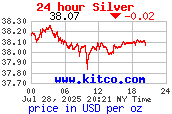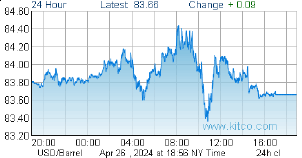It was a watershed week in our view for the CDNX which went into quick reverse last Monday morning after gapping up and reaching a new two-and-a-half year high of 2465. The Index finished 16 points lower Monday at 2424. The selling then intensified over the next three days with losses of 38, 59 and 87 points. The market gapped down further first thing Friday, touching its 100-day moving average (SMA) of 2192, before reversing sharply during the day Friday (on lower volume) and closing higher at 2267. What are we to make of the 173-point, 7% weekly drop? Was it a short-lived pullback or the beginning of a more severe correction? We believe the latter is the case within the context, however, of an ongoing bull market.
Over the years the CDNX has proven to be an exceptionally reliable leading indicator of trends in the broader markets and precious metals. Last July, for example, the CDNX led all markets out of the doldrums which enabled us to make a bold and correct call that the correction was over and a major buying opportunity was at hand with the potential for a massive upside move in the CDNX. Indeed, the Index climbed 1122 points or 83.5% from its early July low of 1343 to last Monday’s high of 2465. The action in the CDNX last July also led us to predict that Gold was about to make a major move which indeed it did.
We believe there is a high probability that we are at another turning point in the markets, confirmed to us by last week’s overall bearish action in the CDNX. Now before everyone goes into a panic, keep in mind that the bull market in junior resource stocks still has a long way to go. In fact, a healthy correction at this point will give the CDNX the strength and energy it needs to finally blast through stiff resistance and take a run at much higher levels. The rising 200 and 300-day moving averages, which are in no danger of declining, confirm the impressive “big picture” technical health of the CDNX and the fact that the bull market is entirely intact.
So what is it, specifically, that we find worrisome about the CDNX right now?
- The market has clearly met powerful resistance between 2438 (the Feb. 22 high) and 2465 (the March 7 high). This resistance area is very clear to see on John’s multi-year chart below;
- Exhaustion appears to have set in – the CDNX has climbed 83.5% over the last eight months. Buying pressure is at a level (“pivot point”) where other pullbacks have started;
- The CDNX is now significantly under-performing the major markets. Given the fact the CDNX is such a reliable leading indicator, this suggests to us that the broad markets are about to go into a major reversal which will obviously negatively impact the CDNX. It’s possible that Gold and commodities in general could also slide. The CDNX fell 7% last week vs. setbacks of 1% for the Dow, 2.4% for the Nasdaq, 4% for the TSX, and 4% for the TSX Gold Index. After crushing the Dow in terms of percentage gains during the third and fourth quarters last year (21% to 11% and 34% to 7%), the CDNX is now slightly under-performing the Dow in the first quarter of this year. That’s a divergence we don’t like, especially with precious metals and commodities as strong as they’ve been recently;
- The CDNX has fallen below its 50-day moving average (SMA) for the first time since the start of the big run last summer. In almost all cases over the last decade, with the notable exception of 2009, a drop below the 50-day SMA following a significant uptrend has preceded a major correction;
- The possibility of a declining 50-day SMA in the CDNX is now an imminent possibility unless this market can quickly move and stay above 2300 where it will now find resistance;
- The 20-day SMA is accelerating to the downside, putting additional pressure on this market;
- Too many individual stocks have broken down on the charts;
- The fact the CDNX would experience a drop like last week and show technical weakness at a time when Gold is hovering around all-time highs is extremely troubling.
Below is a copy of John’s CDNX monthly chart going back to 2001 that we posted Wednesday, March 9. Note the resistance band and the high buying pressure at major “pivot points”.
Bulls will point to Friday’s intra-day reversal, the support of the 100-day SMA, and the bullish engulfing candle pattern that formed Thursday and Friday (the engulfing pattern requires confirmation Monday and Tuesday) as evidence we’ve seen the bottom of this mini-correction and the market is ready to roar higher. That is one interpretation and there’s a chance it could be correct (a chart from John below shows how the bulls will draw encouragement from Friday’s trading). Another interpretation, one that we believe is more valid given the above eight points, is that Friday’s trading and any additional strength this coming week amounts to nothing more than a “bear trap”.
Friday’s intra-day reversal in the CDNX was not hard to predict as the market was getting into oversold territory and there is strong technical support just below 2200. There’s a chance the CDNX will try to take a run this coming week at its 50-day SMA at 2320 but this attempt, if it occurs, is likely to fail given the factors cited above.
Corrections in the CDNX of 20 to 30% typically occur every year during a bull market phase. If one is prepared for such an event and can take full advantage of it, this is how fortunes are made. A pullback of 23% from the 2465 high would take the CDNX down to 1904, last November’s low, which is also in the vicinity of both the 200-day SMA and the 200-week SMA which will provide rock-solid support.
Fundamental factors could quite possibly create a difficult environment for stocks over the next two to three months. Continued unrest and uncertainty in the Middle East, rising oil prices, debt problems from Europe to the United States, and now the devastation in parts of Japan from Friday’s massive earthquake and tsunami are all factors that could negatively impact the markets going forward. Japan is the third largest buyer of U.S. debt after the Federal Reserve and China and is going to have to spend hundreds of billions of dollars rebuilding critical infrastructure. The country is facing its worst crisis since World War 2.
In Canada there is a growing possibility of a federal election which introduces more uncertainty for Canadian investors.
Gold fell $13 last week to $1,420 while Silver, which has been consistently outperforming Gold in recent weeks, gained 13 cents to $35.90.
The fundamental case for Gold remains incredibly strong – currency instability and an overall lack of confidence in fiat currencies, an extended period of negative real interest rates (inflation is greater than the nominal interest rate, even in China and India despite increasing rates there), massive government debt from the United States to Europe, central bank buying, flat mine supply, physical demand, investment demand, emerging market growth, geopolitical unrest and conflicts (with the volatile Middle East being the focus right now), rising oil prices…the list goes on. It’s hard to imagine Gold not performing well in this environment.
Despite signs of an improving U.S. economy, the Fed is expected to error on the side of caution and maintain its accommodative monetary policy for an extended period which is bullish for precious metals and commodities in general. The Fed will want to see payroll gains in excess of 200,000 for at least six to nine months and a significant decline in unemployment before withdrawing its massive monetary support (QW2). The current U.S. economic expansion is just 20 months old (expansions since WW2 have tended to be at least 60 months) and there are still significant risks to the economy including troubling high levels of debt at every level of government, a housing market that is still weak (one in four mortgages are underwater and prices continue to decline in many areas) and now an increase in oil prices which has the potential of hitting consumers hard. Interest rate increases in the U.S. appear to be out of the question until at least sometime next year. Overall, this is the type of environment that’s very supportive of Gold and a speculative commodity-driven market such as the CDNX which is why we see any pullback in the CDNX, minor or major, as merely a correction within a powerful ongoing bull phase.
 BullMarketRun.ca
BullMarketRun.ca










I think the TSXV did peak in mid February. The US dollars current weakness if it continues to weaken below where it is now, could cause gold but especially silver prices to spike up. Yet, most of the analyists I follow think silver and gold are at highs and are going to correct, short term. Nobody wants to be left out, so the longs and shorts on silver. Cash is your friend. I don’t understand how to use options for protection. By the time I have taken profits on my good mining stocks, the remaining mining stocks in the portfolio are my core, which are not exactly the ones I’d like. I guess I have way too many positions. Anybody got any suggestions? I am LONG TERM HOLDER OF GOLD BULLION DEVELOPEMENT. There is a proxy vote before March 16, for us not attending the annual meeting. Can someone from Bull Market Run tell me how they would vote for each of the 5 items?
Comment by George Helm — March 14, 2011 @ 5:59 am